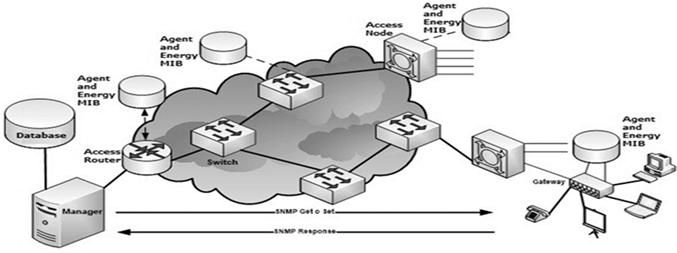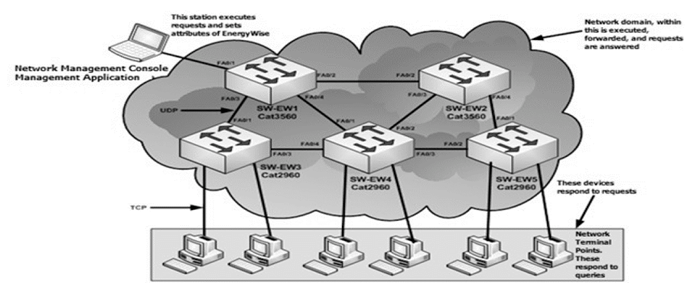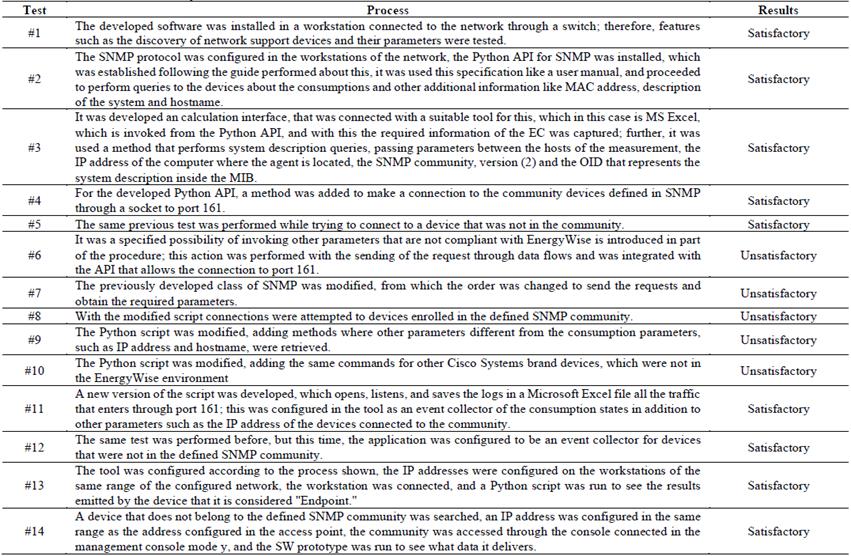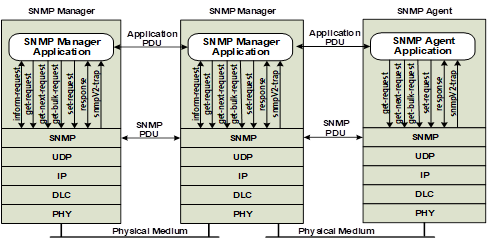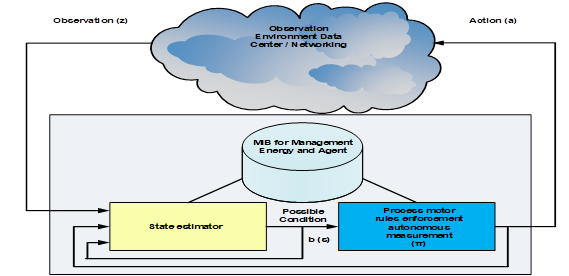1. Introduction
In this study, a tool is developed to measure and monitor the energy consumption (EC) of devices conceptually connected to a network or passively part of it. The tool is based on standard measurements and uses data export methods. Power consumption (PC) graphs and charging information are provided for each measured device. Consequently, vital measurement results, which are obtained by collecting measured data from various devices in a goods, networks, and services (GNS) system [8], can be realized. This tool represents the starting point toward other more complex tools, which can control network infrastructure and operate energy-saving techniques when traffic conditions change [1, 21]. Considering this, the required area of knowledge, in addition to the other previously explored areas, is software engineering and development, as well as the concepts and methodologies for managing EC variables in GNS-type schemes. Therefore, the inclusion of these areas of knowledge is considered because they provide the necessary resources for developing the final product [23].
2 State of the art in Energy Management (EM) systems
The state of the art in EM systems is supported by the need for environmental conservation, which is a decisive part of global warming issues, adding to the recurring world trends, thereby seeking to implement a more rational culture in terms of EC by part of all schemes that make up a GNS-type system. Data networks and their management in areas of EC and electrical variable measurements have radically evolved and transformed into a concept that can be extrapolated to smart grid models, which is characterized by obtaining the mechanisms to achieve improved energy efficiency, thereby acquiring the adaptive management capacity of available GNS-type systems [1,4,6,7].
EM systems can be integrated with systems that help digitize a domotic environment, and the infrastructure provided by network devices can support the EC measurement process. In addition, if management standards that allow determining the possible values that represent the PC in domotic environments are in place, it encourages consumers to participate [25]. Energy measurement systems in GNS-type environments provide detailed information on the resulting EC patterns, allowing potential users to adopt energy-efficient behavior. The objective is to determine the particularity of including energy efficiency factors in the use of the same data networks, thereby rationally and efficiently projecting a culture of methodological use in the application of network equipment. Several global strategies seek to reduce reliance on hydrocarbons-oil, gas, and coal-as the primary source of energy as well as addressing the issue of inclusion with increased use of clean energies such as electricity; however, it is neither expected to occur in the consumption that the basic infrastructures of the data networks have nor in the GNS-type schemes that they support [1,8,10,19,20].
The EM-type systems currently used in network devices are structurally defined to be addressed as protocol processes that read state variables according to the paradigmatic management standard employed in certain instances; this part is extrapolated from [27-30]. Particularly, EM-type systems can be used with advanced analysis technologies and through structured telecommunications processes to provide actionable information structures and management functions to a defined layer of consumers, while also ensuring their usability, availability, security, and privacy [26]. In this study, an experimental method for applying EC variable-reading schemes is presented using protocol concepts of open and closed management standards from the perspective of network equipment technology providers, with which it is defined an extrapolated EM-type frame. How EC variable-reading schemes are applied in network equipment systems that support the simple network management protocol (SNMP) and the concept of management information base (MIB) associated with EC have been investigated [1,22-24].
Convergence is sought to be achieved in the part of electrical energy and information technology (IT) services, and its associated measurable consumption is a very extensive issue with many variants and possibilities that require using technological management (TM) tools. To delimit this, it is paramount to define respective scopes, in addition to selecting the technologies that can be used for EM, which must be present in the network equipment. This should be reflected in a global and standard trend; in addition, it should focus on relevant parts to define a measurement strategy for vital electrical variables [12-18].
The application of TM methodologies in the energy part discussed here use an experimental method that starts from concepts known as SNMP with their existing associated MIBs; therefore, it is appropriate to consider that parameters required for reading from these databases should be defined in the EC part. If a search is made for information related to the partial application of TM techniques in the EC part, it is possible to obtain relationships between the meters-the principles of digitization and the specification of Internet of things objects-and their participation in the smart grids. In this case, we can consider smart meters and technologies currently used to measure electrical parameters. However, the outlined approach is based on using management protocols applied in network equipment that support GNS-type system infrastructures [1,4,6,23].
Then, there is a directive to have robust and reliable systems that provide the facility to allow users not only to be consumers but also energy providers, in addition to considering other innovations that make it evolve in this aspect, including in the solutions proposed in the use of IT.
3. Software modeling conditions for power measurement
For the task at hand, the baseline is adjusted using a generic EC model based on the energy status of goods and services connected to a network, which supports the energy management capabilities [1]. Considering this, the premise includes measurements of status from the devices, such as on/off/hibernation or functional sleep, to consider the EC per bit, per interface, per request, and satisfying the quality margins in the service network level-the quality of service (QoS). This helps narrow down the task at hand and proposed approach. Because of not being able to apply the concept of life cycle analysis in every sense, a measurement of performance related to the eco-indicator, which was applied in previous works [2,16-18], is proposed.
With this like objective, a person can remotely inspect the PC and even make changes to the power management (PM) settings. Thus, a new MIB scheme, which can handle and capture the attributes of importance, is introduced. The core is to start from an agent-based management architecture that makes it possible to reduce the PC in network equipment [1]. Different facilities, such as government offices, universities, businesses, or individual households, usually have enormous digital equipment, including wireless routers, internet protocol (IP) devices, and printers. Many of these devices consume more energy in standby and hibernation modes, e.g., printers, considering the amount of time they are inactive within 24 h, rather than in active functional use [3]. Hence, most electricity consumption is used to keep network hosts fully functional just to maintain network connectivity or "presence" to respond to the expected user traffic that often does not arrive [21].
Within the last two decades, new types of services such as open television (TV), high-definition TV, IP TV, online games, and Voice over IP (VoIP) have thrived. These services have increased bandwidth requirements and must be incorporated together with normal network traffic. In addition to this, these services can only tolerate a minimum amount of packet loss, delay, and jitter. Therefore, IP traffic is always increasing, and the capacity of the equipment needed to process and direct this traffic must grow at the corresponding rate. Another significant implication is an increase in the PC of network-enabled equipment [6].
Hence, it necessary to adopt the trend by hardware manufacturers to innovate and find new processes to help build improved EM schemes [7]. As a result of this trend, it is feasible to define the energy states for various devices and create more efficient cooling systems for data centers. Particularly, new electronic devices can be put in the state of suspension, thus reducing EC when they are not in use. Studies have been conducted in the EM field, focusing on the prediction schemes of waiting time, frequency-voltage scaling, and stochastic control methods [19].
The need of being aware of EC is also related to QoS management processes, hence directly related to the user and the services he/she demands. Notably, there are techniques of monitoring and limiting such use, which significantly contribute to achieving the goal of reducing the EC of network equipment.
The problem we must handle is how the power state of the attached and associated network equipment in a GNS system can be disposed, exposed, controlled, and measured in a standard compatible way with the existing network management protocols in the measurement that provides a level of EC framed with QoS parameters on a per-user and per-service basis [9]. The core of the foundation to define these and consider a generic EC model establishes that the provisions must be integrating and scalable and that they can be directly used in devices connected to the network, from which information can be extracted and related to energy savings in different scenarios, which is consigned in a MIB scheme.
Following the above, the following are considered [13-15,18], and this process can be viewed in the Fig. 1:
Design a MIB compliant scheme for EC in related devices in a GNS system.
Specify a generic model of PC at the system level.
Have an autonomous architecture that can measure, monitor, and control the use of energy by users and applications.
We aim to use a management protocol applicable to this case; we considered the SNMP, which is for remote management of network devices. A network managed with the SNMP comprises three parts [16, 17]: the managed devices, management agent, and network management systems.
a) Managed devices: They are defined within a GNS system and can be from any piece of equipment in the data network and compatible with the SNMP. Among the cases to be analyzed for managed devices are routers, switches, hubs, workstations, and printers.
b) Management Agent: This is usually software that resides within the managed devices. It is responsible for collecting data from the managed device and translates that information into a format that can be passed through the network using the SNMP.
c) Network management systems: A network management system issues requests, and the devices return responses. Network management systems and the respective agents communicate through messages, such as GetRequest, SetRequest, GetNextRequest, GetResponse, and Trap.
This objective is based on the analysis of the GNS sets, which must have some form of EM as well as network management capabilities. The industry-standard advanced configuration and power interface (ACPI) is used to define common interfaces for hardware recognition, device configuration, and PM [1]. The ACPI defines the states as shown in Table 1.
Considering the correlation offered by the states of the devices, the topic to consider in principle is PM, which should provide a device with capabilities to turn on, turn off, or put the entire system or subcomponents in an active state after a fixed period of user inactivity [6].
Achieving a balance between energy-saving and EM is essential; therefore, the total effect of dynamic EM, which is focused on policy development to increase energy savings, including device performance at the system level. Consider hard drives, handling them can help extend the life of a battery by minimizing PC because performance may reduce, as they can respond slowly to user requests [11,12].
Therefore, considering the objective of this study and EM policy, it essential to predict the possible states and times of use, in such a way that they do not affect the user through active/awake changes. [6].
When considering the implementation details, the SNMP is immediately introduced into the design, which can be applied for remote management of network devices; In fact, this study reviews the behavior of a network in which the concept of the GNS system is embedded. The important thing is to consider how PC states are managed, thus exploiting the levels that denote QoS in the network to make network devices able to reduce EC and maintain operational statuses and functional services [1].
To address the case of the application of eco-indicators, this starts from the definition that the total EC necessary to perform a job is defined as the sum of [22] the following.
The power required to move a packet from one computer to another within a network.
The power required to transition to a transition state, e.g., “Warm Up” to the “Ready” power state.
The EC necessary to maintain the operating states of the components, e.g., storage, dispatch, and routing.
Considering the three aforementioned aspects, which have considerable potentials to reduce energy in a network environment, and meet the requirements in the developments under investigation, a MIB for power control and management- Energy-Aware MIB-is proposed since this allows a network administrator to remotely inspect the PC in the network components at the system level [24].
4. Data collection techniques
Following the organized and structured objective of this initiative, it is necessary to have a series of strategies to collect and analyze the relevant information, which should be performed through observation processes; this is justified by the fact that it is necessary to have the relevant information of the primary and secondary source types. This mechanism is used to abstract the concepts of ease of use, performance, operation, user requirements, and generalized ideas, which will complete the final result.
The techniques used are functional tests of software tools (test versions, evaluation, or free form), management information capture tools in which the SNMPv2 management protocol is applicable, the use of brainstorming, cases of use, interviews or surveys with experts or a knowledgeable person in the area, consultations to books, indexed journals, online resources, and articles related to the research topic [1].
5. Software solution recommendation
Once related tools that make up the current situation of EM in the GNS system can be obtained, the functionalities and characteristics of these tools that can be extrapolated are described below, and which points to the characteristics and functionalities of the software design and proposed in this initiative as an EM tool. The developed prototype does not constitute a complete administration tool since it only touches the necessary points, and some of the characteristics are allowed by the Cisco EnergyWise standard, which is compatible with SNMP [1].
The product derived from this development may not be a comprehensive solution for total EM. The elements of judgment and value to perform this work focus more on developing a tool that is introduced to those that can comply with the network management standards related to EC environments, which is because our goal is to make measurements in the GNS system of an ICT environment. The software prototype has been designed and developed following the theory, software engineering specifications, and a development methodology in relation to the network management and PC standards allowed by the architectures under observation. Therefore, specific parameters of the characteristics of each equipment are used, which allow developing a functional software prototype that complies with the management requirements in SNMPv2 identified during functional tests and information collection processes [1]. In the process of seeking to provide the opportunity to develop a modular management tool that can be completed and strengthened, and from which anyone can resume the research work started here and complement it, to develop a more complete management solution.
Perhaps the greatest motivation for performing this work is abstracting theoretical and practical concepts in the area of network management and EC and extrapolating their characteristics, model them, and automate them by developing a software prototype. Considering the latter, it is likely that for many this way of achieving the objective set, it could become something invalid to justify the viability of this objective, but for its authors, this confirms that the entire process development allows to achieve the desired result [10].
6. Selection of software development platform
The software development platform for constructing the prototype must be in an object-oriented language due to the development methodology used, which rules out the adoption of the C language since it is not object-oriented. Moreover, the language in which the prototype is developed must guarantee its portability, i.e., it can be run in Windows, Linux, and Unix environments; the development platform must also allow the prototype to be executed from an Internet browser and to guarantee a client/server environment, where the client does not have to install the tool in a full implementation [3].
With the abovementioned requirements, Python was selected as a development platform; languages such as Java and C ++ are indeed object-oriented, but they do not offer the portability, libraries, and execution characteristics for the proposed prototype [21].7. Software development methodology
7.1 Specification of the solution prototype
As mentioned, the solution is SNMPv2 compliant, and due to the consideration of the devices used in Testbed for this purpose, the concept used to perform PM is Cisco EnergyWise, which is a proprietary product. The reference of this product established in version 2.7 and higher, such as those used for this purpose, is integrating a new feature, which is the configuration of an SNMP proxy. Therefore, it is possible to review and manage SNMP systems, such as a switch or a router, as if they were native power support terminals without problems [5]. This is indicated in Fig. 2.
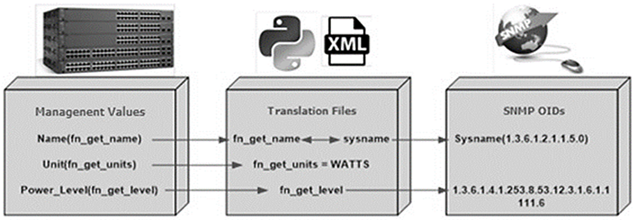
Source: The Authors.
Figure 2 Schematic configuration of manageable network topology with a management environment supported in SW and supported for obtaining parameters by a management protocol.
In practice, the SNMP proxy is configured on the port of a switch connected to the SNMP device. An XML file arranged in the memory of this switch will allow the translation of energy requests and vice versa using the SNMP protocol. Obviously, it will be necessary to write a translation file for each different device that you want to control because the SNMP protocol has defined everything in its structural tree. To do this, it is necessary to find the MIB of the team and extracts the OIDs that are interesting and relevant to an extent [20].
Setting up an SNMP proxy is not very complex. The difficulty lies in creating the translation XML file in which it is necessary to extract the OID of interest from the SNMP MIB system. In addition, if many different SNMP devices exist, it can be cumbersome to write a different XML file for each one [4]. To remedy this, it is possible to determine models and templates and then modify the observed GNS system’s access concept.
The prototype topology used initially and from which a higher level of complexity can be derived is that determined in Fig. 3, which shows a topology comprising largely of Cisco Catalyst 3560 and 2960 switches [5].
7.2 Report of realized functional tests.
As mentioned above, functional tests were performed, such as activating some hosts on the network, and those with a technical nature, such as forward traffic between hosts, which was evidenced in the collection of requirements. The functional tests performed with the developed tool allowed obtaining the requirements, which are consulting the OID of the SNMPv2 objects of the devices present in a data network. The tests were also performed with the SNMP API, hence elucidating the operation and how to implement an EM process in a GNS environment, which was extracted in the queries to the resident SNMP agent and activated on network devices. See the test results in Table 2.
7.3 Definition of functional testing requirements
Current network platforms that support Cisco EnergyWise include fixed chassis switch models, such as the Cisco Catalyst 2960X, 3560, 3560-E, 3750, and 3750-E Series, as well as the Cisco Modular Switch series Catalyst, including the 4500 series, and all platforms that support the appropriate modules for EtherSwitch®. For Cisco switches with fixed modules and the possibility of implementing EtherSwitch®, it was necessary to update the Cisco IOS SW, at least to version 12.2 (53) SE1 or later, with the IP-Base operating system profile or with IP services, so that the set of features used by Cisco EnergyWise Orchestrator was compatible. For Cisco Catalyst 4500 series switches, agents must upgrade to Cisco IOS software version 12.2 (54) SG or later. To support Cisco EnergyWise with Cisco Catalyst 6500 series switches, IOS software must be managed from version 12.2 (33) SXI4. Additional support for other Cisco PoE products is still said to be in the planning stage.
This management concept supports Cisco ISRs, which in turn have support modules for EtherSwitch®; it is in the second generation, whose Cisco EnergyWise support platforms use a version of Cisco IOS Software Release 15.0 (1). M2 or later.
This energy measurement process can be extrapolated and supported on the SNMP concept (Fig. 4).
8 Comparison between energy measurement schemes
Some measurement system models were considered for the analysis, corresponding to many manufacturers; some of them have been used, at least experimentally. The comparison was made on devices that can be considered "smart" since they have the following basic features:
Bi-directional, local, and remote measurement functions, and in real time of electrical energy.
Local and remote measurement of basic parameters: power (instantaneous, maximum, and minimum), voltage, current, and power factor.
Protocol configuration of management functions applied in their functional operations.
Capacity of functional control of the load or eventual remote disconnection of users.
Based on these minimum characteristics, which allowed considering smart measurement processes, the features that differentiate them were compared. It is recommended to point the results obtained to the latter since they are the ones that show the enormous potential of the functions of network devices, especially as these technological trends are emerging as predominant and the recommendation is to achieve them.
The objective of the comparison was only technical, not commercial, which allowed not individualizing all the characteristics by brand and model; only conclusions are given at a general level.
From the comparison that could be made with the measurement models cited here, the following are determined.
a) What initially allows an initial categorization of measurement models is the way to define their construction. Thus, one can consider the network devices that have a special MIB for energy measurement, as well as the teams that have structured in their manufacture the way to measure PC. Regarding this aspect, a clear trend, current and future, toward the first mentioned form is determined since basic units are built according to a protocol that later allows adding modules with additional functions.
b) Another characteristic feature that differentiates the different energy measurement models is their ability to collect information on the quality of the energy supplied (service interruptions, harmonics, transients, “sags,” “swells,” etc.). However, this is conjectured since they are measurement states made by protocols and not by meters, which have the possibility of permanently recordingparameters, providing valuable information, especially from the perspective of network operation.
c) The greatest differences in making measurements in relation to communication facilities are shown, either with data concentration centers that must be supported using data transport mechanisms or with the protocol-specific disposition of each device to do so. Notably, all network devices that are approached to perform energy measurements that have been reviewed, have these capabilities. The most widespread systems, at least for information exchange between the measured devices and possible data acquisition centers, are wireless, which can be based on GSM or GPRS technologies, or with IEEE802.11. There are also other wired solutions with interfaces, such as RS232, RS485, IEEE802.3, or PLC. Regarding this, there is a predominance of wired systems of the Ethernet type or wireless networks.
d) Finally, an analysis has also been made of the different versions of measurement and operation resource management software offered by manufacturers, compatible with their meters.
The process of acquisition of energetic parameters for the application and what was compared are shown in Fig. 5.
10. Conclusions
Using PM standards is not that simple, as the level of applicability of OID and MIB is complex, even when they are open standards.
Each device manufacturer imposes its access criteria and interfaces. Some work in collaboration with open standards consortia to support access to EC data, enabling them to fully participate in energy-saving opportunities.
The next steps would be to relate the prototypical studies to test the response rates and the reading strategy of the community agents with software suitable specifically for the target population.
To work with the SNMP standard to capture EC data, it is still valid to apply the old and good basic principles of network organization, such as segmentation.
To introduce the management of EC in a GNS environment, it is necessary to have devices that support the necessary agents that provide the data; without them, alternative invasive data capture methods could be used with precision costs.
Managing PC is considered to significantly influence IT environments. It is recommended that each project for the implementation of GNS consider the use of EM technologies to achieve the energy-saving objectives.
Currently, the network equipment makes available a tool for energy measurements. The devices can be purchased accompanied by EM tools in general, especially aimed at use by energy distribution companies. Undoubtedly, any energy measurement system that intends to be adjusted within the so-called "smart" ones must have adequate software resources. However, the heterogeneity observed in the offer seriously conspires against the possibility of updating its various components. Thus, this should be an aspect especially considered when seeking the standardization of EC measurement systems.














